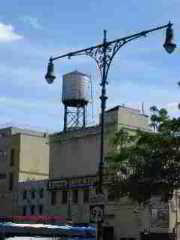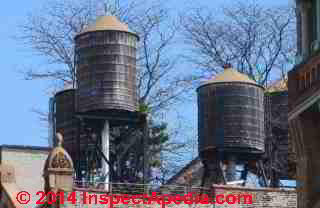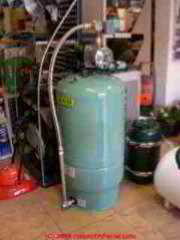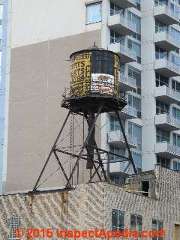 Rooftop Water Tanks, Cisterns & Free-Standing Water Storage Towers
Rooftop Water Tanks, Cisterns & Free-Standing Water Storage Towers
Rooftop water tank types, materials, properties, history
- POST a QUESTION or COMMENT about rooftop water tanks & cisterns
Rooftop & tower-mounted water storage tanks:
This article describes rooftop water tanks and cisterns and tower-mounted water storage tanks, where they are used, how they work, and the use of booster pumps to improve water pressure in buildings with rooftop water storage tanks.
We include water tower design considerations, codes and standard references & citations. We also discuss using a booster pump to improve building water pressure in buildings with weak municipal water pressure or a weak rooftop.
Shown at page top, a rooftop water tower in Chicago. This tower illustrates a traditional woood-stave water tank design that has been in use for more than 100 years.
InspectAPedia tolerates no conflicts of interest. We have no relationship with advertisers, products, or services discussed at this website.
- Daniel Friedman, Publisher/Editor/Author - See WHO ARE WE?
Rooftop Water Tanks, Water Towers & Other Water Storage Systems

Rooftop water storage tanks In some areas, Mexico, for example in our photo (above-left), rooftop water reservoirs are supplied intermittently with water from a water main in the street.
[Click to enlarge any image]
In cities where the municipal water system delivers functional flow and pressure rooftop water tanks are commonly used on buildings that are six stories or greater in height to collect and then deliver water at functional pressure to the floors below.
But in much of the world even single story structures may make use of a rooftop water storage tank, usually elevated above the rooftop by another meter or two, to deliver functional water pressure to the plumbing fixtures located in the building below. It is the added height of the water tank (or in communities, the water tower at heights over 100 feet with a large tank serving the community) to deliver water at pressure.
The rooftop water storage tanks in this photograph from San Miguel de Allende in Guanajuato are being used both to accumulate a water reservoir so that water is always available to the building, and to supply water at a useful pressure.
Our page top photograph of large rooftop water storage tanks was taken in Manhattan.
Rooftop storage tanks atop tall buildings have been in use for hundreds of years - the water tank shown at page top was constructed of wood with iron bindings and is used to provide good water pressure to fixtures in the multi-story building it serves.
In our photos below we illustrate both single and multiple rooftop water storage tank installations observed in Manhattan and in Brooklyn, NY
. In New York City elevated water towers such as those shown above below have been in use since the late 1800's. - The New York Times (2014).
See additional water storage tank details
at WATER TOWERS
Also see CISTERNS, WATER STORAGE.
Rooftop water storage tank support construction need to consider these design points:
- Covering: to protect the stored water against contamination
- Overflow handling: to direct overflow to ground level
- Circulation within the storage facility
- Gravity loads: the dead weight of materials of the water tower & storage tank construction
- Live Loads: the varying weight of water stored in the tank depending on the water level to which the tank is filled. See our notes below about wood rooftop water tank weight.
- Wind Loads: varying by terrain conditions and geographic area, water towers need to withstand loads from hurricanes, hilltop winds, confined areas creating a wind-tunnel effect.
The design engineer or architect for a water tower will consult a data source such as the International Building Code (IBC) where the code provides wind speed data at 30 feet above ground, and will add consideration for tower height, shape, location within local terrain, weather exposure (sun, snow, wind), etc.
For example a design wind speed of 80 mph translates to a surface pressure of 18 psf (0.00256 * the speed of the wind); tower designs need to allow for the maximum anticipated wind speed at the site. In coastal areas this may mean a wind speed allowance of 150 mph. - Fire code concerns: exposure to wild fires
- Enclosed non-residential towers vs. enclosed structures that may add heating requirements
- Access: for inspection, water tower interior cleaning, inspection & testing, maintenance, repair: ladders, stairs, etc. as well as light & ventilation for enclosed structures.
Weight of a Wooden Rooftop Water Tank (with many assumptions)
Reader Question: how much does a 16 ft. x 16ft. wood water tank weigh?
2016/03/17 Ray said:
how much does a wood andersonville water tank weigh 16h x16w dry
Reply:
I cannot say for sure since I don't know what Anderson water tank tank you are describing. Are you referring to a specific water tank such as the Anderson wooden water tank / tower built in 1927 and removed in March, 2014? This tank was removed from the Swedish American Museum in Chicago.
But we can get a ballpark estimate of the weight of any wood structure if we know its dimensions and the thickness of wood used.
The weight of wood varies by wood species.
Wooden water towers are still made by several manufacturers, depending on where in the world the wood water towers/tanks are required.
In New York City Rosenwach (in business since the civil war in the U.S.) and Isseks Brothers (in business nearly 60 years) make wooden water towers or tanks, typically in 10,000 gallon size. American Pipe also produces wood rooftop water tanks for NYC buildings.
From what I've read, rooftop water tanks often use redwood so we'll use that for our wood rooftop water tank weight calculations.
- American redwood weighs about 28 lbs per cubic foot.
Let's "unroll" your 16'x16' redwood water tank and assume these dimensions:
By your quote of a tank that is 16 ft w I assume means 16 ft. (round) diameter water tank. Converting a 16 ft. diameter to circumference gives us about 50 ft. (pi x diameter = circumference).
- So our tank sides are 50 ft. (around) x 16 ft. (high) or 800 sq. ft. water tank sides
Let's add a flat tank bottom (pi r2 = area of a circle) of the same diameter (r = radius = 1/2 diameter)
- 3.1416 x 8ft2 = 200 sq. ft. water tank bottom
If the top were flat we'd use another 200 sq. ft. (though I bet the top of your water tank is a cone so I'll use a larger area of 300 sq. ft. for your water tank's top).
- 300 sq. ft. estimated water tank conical top area
Adding those up we get
- 800 (sides) + 200 (bottom) + 300 (approximate area of a conical top) = 1300 sq. ft. of redwood for all of the wood rooftop water tank's surfaces
Now we need the tank thickness: Let's assume our redwood is 1 5/8" thick (that's pretty common thickness for water tanks).
- That's 1.625" wood thickness
We need all of our wood in the same units. 1 ft = 144 sq. in.
- 1300 square feet x 144 = 187,200 square inches of wooden rooftop water tank surface area
Let's now get the cubic volume of our whole wooden water tank (surface area x wood thickness)
- 187,200 sq. in. x 1.625 in. of thickness = 308,880 cubic inches of wood in our make believe water tank
Let's now convert our cubic inches back to cubic feet: 1 cubic inch = 0.000578704
- 308,880 cubic inches = about 180 cubic feet of dry American redwood in your imaginary water tank.
Weight of the Empty 16 ft. x 16 ft. Redwood Water Tank
Now let's weigh our cubic feet of redwood: At about 28 lbs per cubic foot that's
- 180 x 28 = 5040 pounds of redwood water tank as long as the wood is dry
Weight of the 16 ft. x 16 ft. Redwood Water Tank Filled with Water
et's fill up your wood water tank and weigh it. The volume of a cylinder is pi * radius2 x height so our water tank will hold, if filled to the brim,
- 3.1416 pi x 8 r2 x 16 h = 3216 cubic feet of water in our tank (By the way that's about 24,000 gallons)
- One cubic foot of water weighs about 62.4 pounds
- 3216 x 62.4 = 205,824 pounds of water in the water tank
Weight of a Water-Filled Rooftop Water Tank
So our full water tank, before weighting its supporting structure or roof covering, pipes, nails, ladders, scaffolding and other nice features, weighs - if my math is right. If it's not I trust some readers will help me out
- Filled rooftop water tank weight = 205,800 lbs (water) + 5000 lbs (tank) = 210,000 pounds total
Thai's before adding features like ladders, roofing, hardware, pipes & the supporting structure between the tank and the roof and the additional structural members to carry this weight down to the ground and foundation.
Rooftop Water Tank Construction Standards & References
- Bhardwaj, Vipin, "Reservoirs, Towers and Tanks, Drinking Water Storage Facilities", National Drinking Water Clearinghouse, West Virginia University, P.O. Box 6064, Morgantown, WV 26506-6064, retrieved 4/15/14, original source: http://www.nesc.wvu.edu/pdf/dw/publications/ontap/2009_tb/reservoirs_towers_tanks_dwfsom15.pdf
- (CSA) B126 Series-13 Water Cisterns, available from the Canadian Standards Association or CSA at https://store.csagroup.org/, retrieved 2018/09/11, original source: https://store.csagroup.org/ccrz__ProductDetails? viewState= DetailView&cartID=&sku= CAN/CSA-B126%20SERIES-13&isCSRFlow=true& portal User=&store=&cclcl=en_US&gclid= Cj0KCQ jwz93cBRCrARIsAEFbWshjpB4Qgr HuL5eMpmRiVwjbShi1gG- bMna-6U j8vP27a G9ACFRJGBQa Aqg6EALw_wcB
Excerpt:
The B126 SERIES-13 - Water cisterns standard helps ensure that drinking water storage systems are properly designed, installed and located to help prevent health risks such as contaminated drinking water and accidents. It will help jurisdictions provide their citizens with guidelines, codes and best management practices to enable the use of these systems locally.
Maintenance recommendations outlined in this standard will help keep cisterns properly sealed and identify any potential structural cracks. Cracked cisterns allow surface water, insects, animals and debris to infiltrate the cavity, leading to unsanitary conditions and personal hygiene problems. Once contaminated, cisterns are difficult to keep disinfected.
Highlights of B126 SERIES-13 Include:
B126 complements another related standard: CSA B128.3 - Performance of Non-Potable Water Treatment Systems, which specifies the design, installation, maintenance and field testing of non-potable water systems for applications such as flushing toilets, irrigating lawns and gardens, washing automobiles, showering, bathing, washing clothes, heating and cooling. - HDR Engineering, Inc. 2001. Handbook of Public Water Systems . 2nd Edition. John Wiley and Sons, Inc.: New York, New York
- Hobbs, Aubrey Thomas (ed.) 1969. Manual of British Water Engineering Practice . Vol 2. W. Heffer and Sons, Ltd: Cambridge, England
- "Fall protection requirements for workers constructing a water tower while on a scaffold", US Department of Labor, OSHA, Standard 1926.451(g) and others, retrieved 4/15/14, original source https://www.osha.gov/pls/oshaweb/owadisp.show_document? p_table=INTERPRETATIONS&p_id=25047
- NFPA 22: Standard for Water Tanks for Private Fire Protection
- Rivera, Ray, Ruynyeon, Frank G., Buettner, Russ, "Inside City's Water Tanks, Layers of Neglect", The New York Times, 27 January 2014
- Rosenwach Group, (Rosenwach Wood Rooftop Water Tanks), 40-25 Crescent St., Long Island City, New York, 11101, Tel: 718-728-4900, Email: info@rosenwachgroup.com
- Isseks Bros., Inc., 298 Broome St, New York NY 10002-3704, (212) 267-2688
- The New York Times, "E. Coli Found in Water Towers at NYC Buildings: Report
The city says the water towers are safe", The New York Times, 27 January 2014 - Excerpt
The city told the paper that its tanks -- the more than 10,000 of them currently in use -- are all safe and that health inspection standards are up to par.
Though dozens of New Yorkers have called 311 each year to complain they've gotten sick from drinking tap water, the city says none of the illnesses have been traced back to the tanks, according to the Times. - New York City Health Code Requirements for Cleaning Water Tanks, NYC Department of Health and Mental Hygiene Office of Public Health Engineering Water Tank Inspection Reporting 42-09 28th Street, 14th Floor Long Island City, NY 11101-4132 - https://www1.nyc.gov/assets/doh/downloads/pdf/notice/2016/noi-chapter31-title24.pdf retrieved 2018/07/31
- "WAC 468-240-205 Obstruction lighting standards—Water towers, grain elevators, gas holders and similar obstructions.", Washington State Legislature, retrieved 4/15/14, original source: http://apps.leg.wa.gov/wac/default.aspx?cite=468-240-205
- "Water Tower", Princeton University, www.princeton.edu, retrieved 4/15/14, original source: https://www.princeton.edu/~achaney/tmve/wiki100k/docs/Water_tower.html also cited at Wikipedia below
- "Water Towers, Building Code, Design & Geologic Notes", water-towers.com, retrieved 4/15/14, original source: http://www.water-towers.com/WtrsCodeNote1.html
- "Water Tower", Wikipedia, retrieved 4/15/14, original source: http://en.wikipedia.org/wiki/Water_tower
- WATER TANK CLEANING CODES STANDARDS - separate web article at InspectApedia.com describes water cistern and tank truck cleaning codes, standards, procedures.
- Wood weights by wood species, Engineering Toolbox, (web page) retrieved 2016/03/17, original source: http://www.engineeringtoolbox.com/weigt-wood-d_821.html
Plastic & Fiberglass Water Storage Tanks - HDPE Tanks
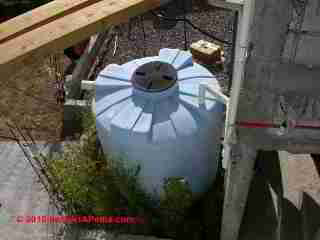 Reader Herman Voegel has pointed out that an up-and-coming area of storage containers includes spun-plastic tanks.
Reader Herman Voegel has pointed out that an up-and-coming area of storage containers includes spun-plastic tanks.
Specifically, new storage tank types include High Density Polyethylene (HDPE), currently available as tank storage for water, chemicals, waste oils, etc..
The plastic water tank in our photo (left) is used on ground level or on rooftops.
See details at PLASTIC RECYCLING CODES, TANKS, TYPES for details about using plastic tanks or containers for water storage.
General HDPE containers come in all shapes and sizes and are quite rugged and relatively cheap compared to using typical 12-gauge steel home heating oil tanks.
The ruggedness of HDPE plastic containers comes from their material density which is typically at a minimum specific-gravity of 1.7, and for heavy-duty at 1.9.
These tanks may be used for storing certain liquids besides water. But home heating oil has not yet been approved for storage in HDPE tanks, basically for two reasons:
- UV (ultra-violet) light degrading HDPE plastics over time, making them weak, and
- Problems with slight permeation seepage through their plastic walls.
However, fixes have been put in place to properly address these problems. UV-light is checked by using special color additives that prevent their light from penetrating and degrading the plastic walls. Permeation or seepage of oil through container walls is checked by coating them with fiberglass.
Unfortunately, even with these fixes, HDPE plastics for heating oil storage have yet to be universally approved and accepted.
Readers should also
see PLASTIC RECYCLING CODES, TANKS, TYPES where we describe health and other concerns involving plastic tanks and other containers used for water storage.
Attic Water Storage Tanks or Attic Cisterns
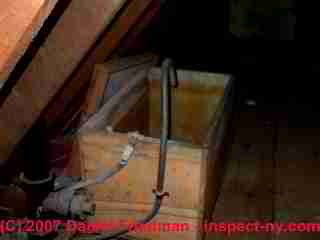
Attic Cisterns or water tanks are installed in some buildings to perform the same function as rooftop-mounted water tanks. I don't consider these "rooftop" water tanks but rather "under the rooftop" or "beneath the rooftop" water tanks.
Other smaller attic containers that look like a water reservoir may have been just an expansion tank for the heating boiler system. Cisterns in basements or attics are an open-type water storage reservoir found indoors, and are discussed further
A cistern was generally placed where it could be fed by gravity from roof or surface runoff, but any indoor open topped reservoir of water could be called a cistern.
See SOLAR WATER HEATER ANTIQUE for another example of an attic water storage tank.
Water storage may not be on the rooftop nor in the attic. Cisterns or other water storage containers are often located in the basement or courtyard of buildings where they collect rainwater for future use. In the U.S. cisterns were often located in the basement of a (pre-1900) home.
See details at CISTERNS, WATER STORAGE.
Rainwater Storage Tanks & Cisterns

In a seasonally damp climate such as New York, an in-use basement cistern would certainly be a likely source of unwanted building moisture and would thus be a risk for problematic mold growth.
In arid areas such as the U.S. Southwest and parts of Mexico, very large cisterns are often placed in a courtyard where they collect rainwater for use during the dry season.
The above-ground water cistern storage tank shown in our photo (left) is located in Mexico and is discussed
at PASSIVE SOLAR HOME, LOW COST.
Rainwater for this cistern is collected from a near-flat rooftop [photo] and channeled to a large fiberglass holding tank - the blue tank in our photograph, (above left).
Piping also permits directing water into this tank from a well-fed cistern located atop the concrete block tower [photo].
The tower's height provides water pressure to the building.
Currently water is taken out of the bottom of this tank by a simple tank drain valve and hose attachment; to supply this water upwards to the building plumbing fixtures or perhaps to the cistern, a small electric pump will be installed.
See rainwater collection and storage cistern details
Water Pressure Boosting Systems
On low buildings or where the water tank is not high above the point of use some systems install a water pressure booster pump and tank.
A water pump and probably a water pressure tank will certainly be needed for ground-level or below-ground-level water storage cisterns.
See details at WATER PUMPS, TANKS, DIAGNOSTICS
and at WATER TANK BLADDERS & CAPTIVE AIR
Water pressure booster pumps and tanks may be installed in buildings where municipal water is supplied,
located on rooftops or anywhere in a building, so
don't assume that just because you see a pump and tank that the building is served
by a private well.
Water pressure boosting systems using a water pump and water tank are also installed
in homes where the municipal water supply pressure is low.
See WATER PRESSURE LOSS DIAGNOSIS & REPAIR for details on how to correct low water pressure in a building.
We discuss water pressure booster pump and tank systems in detail
at PUMP, WATER PRESSURE BOOSTING - pumps to improve water pressure
and at WATER PUMP VARIABLE FREQUENCY / VARIABLE SPEED DRIVE (VFDs) - tankless water pressure systems
Readers of this document should also
see WATER PUMP REPAIR GUIDE an specific case which offers an example of diagnosis of loss of water pressure, loss of water, and analyzes the actual repair cost and
see WELLS, CISTERNS & SPRINGS for a discussion of types of drinking water sources and what goes wrong with water supplies.
If you're looking for information on types of septic tanks see
our SEPTIC SYSTEM DESIGN BASICS which includes articles about various types of septic tanks, steel, concrete, plastic, etc.
Water Tank / Cistern & Water Tank Truck Cleaning
This topic has moved to its own page
at WATER TANK CLEANING CODES STANDARDS
...
Reader Comments, Questions & Answers About The Article Above
Below you will find questions and answers previously posted on this page at its page bottom reader comment box.
Reader Q&A - also see RECOMMENDED ARTICLES & FAQs
Question: where to put the checkvalve for a rooftop tank with no pump
I have a gravity water tank roof top on my house-Water is pumped up by the city when working ok- When the water (municipal) is not working I use the roof tank,
Generally what I do is shut the valve off at the street, then open the valve on the rooftop tank and it gravity feeds down into house.
The tank is located rooftop has 1 line going into the top of the tank for the inlet of water into the tank, the other lines is at the bottom that the water go's into the house..
Where would the check valve be located at? Best place to install it?
Will it interfere with the pressure if the water is only gravity with no pump?
Thank you,
James C. 6/27/2014
Reply:
I'd put the check valve on the tank side of the shutoff controlling water coming from the street main.
In that location the check valve will not be between the tank serving as the building water source and the fixtures and piping that the tank serves.
...
Continue reading at WATER TANK CLEANING CODES STANDARDS or select a topic from the closely-related articles below, or see the complete ARTICLE INDEX.
Or see these
Water Tank Articles
- CAULKS, NONTOXIC
- CHECK VALVES, WATER SUPPLY, DRAINS, PUMPS
- CISTERNS, WATER STORAGE
- FREESTANDING WATER TANKS
- GRAVITY FEED TANKS
- HUD FINANCE & CISTERNS
- LARGE CAPACITY WATER STORAGE TANKS
- PLASTIC RECYCLING CODES, TANKS, TYPES
- RAINWATER STORAGE CISTERNS
- ROOFTOP WATER TANKS
- WATER PRESSURE BOOSTER PUMP
- WATER TANK DIAGNOSIS & REPAIR - home
- WATER TANK CLEANING CODES STANDARDS
- WATER TANK DRAIN VALVE
- WATER TANK LOCATION GUIDE
- WATER TANK SIZE & VOLUME
- WATER TOWERS
Suggested citation for this web page
ROOFTOP WATER TANKS at InspectApedia.com - online encyclopedia of building & environmental inspection, testing, diagnosis, repair, & problem prevention advice.
Or see this
INDEX to RELATED ARTICLES: ARTICLE INDEX to WATER SUPPLY, PUMPS TANKS WELLS & SPRINGS
Or use the SEARCH BOX found below to Ask a Question or Search InspectApedia
Ask a Question or Search InspectApedia
Try the search box just below, or if you prefer, post a question or comment in the Comments box below and we will respond promptly.
Search the InspectApedia website
Note: appearance of your Comment below may be delayed: if your comment contains an image, photograph, web link, or text that looks to the software as if it might be a web link, your posting will appear after it has been approved by a moderator. Apologies for the delay.
Only one image can be added per comment but you can post as many comments, and therefore images, as you like.
You will not receive a notification when a response to your question has been posted.
Please bookmark this page to make it easy for you to check back for our response.
IF above you see "Comment Form is loading comments..." then COMMENT BOX - countable.ca / bawkbox.com IS NOT WORKING.
In any case you are welcome to send an email directly to us at InspectApedia.com at editor@inspectApedia.com
We'll reply to you directly. Please help us help you by noting, in your email, the URL of the InspectApedia page where you wanted to comment.
Citations & References
In addition to any citations in the article above, a full list is available on request.
- Amtrol - AMTROL, Inc.,
Corporate Office,
1400 Division Road,
West Warwick, R.I. 02893
Tel: (401) 884-6300
Fax: (401) 884-4773 The company's website is at www.amtrol.com; also see Amtrol's installation and instruction manual for their Well-X-Trol water pressure control tank, a PDF file - Water Storage: Tanks, Cisterns, Aquifers, and Ponds for Domestic Supply, Fire and Emergency Use - -Includes How to Make Ferrocement Water Tanks, Art Ludwig, Oasis Design (May 30, 2005), ISBN-10: 0964343363, ISBN-13: 978-0964343368, Quoting:
A do-it-yourself guide to designing, building, and maintaining water tanks, cisterns and ponds, and sustainably managing groundwater storage. It will help you with your independent water system, fire protection, and disaster preparedness, at low cost and using principles of ecological design. Includes building instructions for several styles of ferro cement water tanks. - Thanks to aerospace engineer Herman Vogel, July 2010, for providing an update on High Density Polyethylene HDPE storage tanks for water, chemicals, waste oils, etc.
- Smart Tank, Installation Instructions, Flexcon Industries, 300 Pond St., Randolph MA 02368, www.flexconind.com, Tel: 800-527-0030 - web search 07/24/2010, original source: http://www.flexconind.com/pdf/st_install.pdf [Copy on file as /water/Smart_Tank_Flexcon.pdf ] -
- Typical Shallow Well One Line Jet Pump Installation, Grove Electric, G&G Electric & Plumbing, 1900 NE 78th St., Suite 101, Vancouver WA 98665 www.grovelectric.com - web search -7/15/2010 original source: http://www.groverelectric.com/howto/38_Typical%20Jet%20Pump%20Installation.pdf, [Copy on file as /water/Jet_Pump_Grove_Elect_Jet_Pumps.pdf ] -
- Typical Deep Well Two Line Jet Pump Installation, Grove Electric, G&G Electric & Plumbing, 1900 NE 78th St., Suite 101, Vancouver WA 98665 www.grovelectric.com - web search -7/15/2010 original source: http://www.groverelectric.com/howto/38_Typical%20Jet%20Pump%20Installation.pdf, [Copy on file as /water/Jet_Pump_Grove_Elect.pdf ] - Cooperative Extension, School of Forest Resources, web search 07/24/2010, original source: http://pubs.cas.psu.edu/FreePubs/pdfs/XH0002.pdf
- Our recommended books about building & mechanical systems design, inspection, problem diagnosis, and repair, and about indoor environment and IAQ testing, diagnosis, and cleanup are at the InspectAPedia Bookstore. Also see our Book Reviews - InspectAPedia.
- In addition to citations & references found in this article, see the research citations given at the end of the related articles found at our suggested
CONTINUE READING or RECOMMENDED ARTICLES.
- Carson, Dunlop & Associates Ltd., 120 Carlton Street Suite 407, Toronto ON M5A 4K2. Tel: (416) 964-9415 1-800-268-7070 Email: info@carsondunlop.com. Alan Carson is a past president of ASHI, the American Society of Home Inspectors.
Thanks to Alan Carson and Bob Dunlop, for permission for InspectAPedia to use text excerpts from The HOME REFERENCE BOOK - the Encyclopedia of Homes and to use illustrations from The ILLUSTRATED HOME .
Carson Dunlop Associates provides extensive home inspection education and report writing material. In gratitude we provide links to tsome Carson Dunlop Associates products and services.


